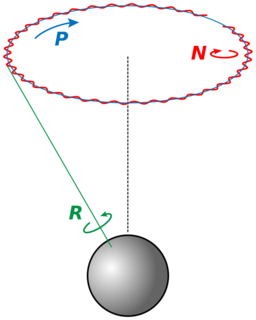6.8: Nutation
- Page ID
- 8168
Those who have studied the gyrations of a spinning top will recall that, in addition to precessing, a top may nutate, or nod up and down (Latin nutare, to nod), the amplitude and type of nutation depending on the initial conditions. Earth’s axis does indeed nutate, but not from the same cause. Those who have studied tops will understand that damping more or less rapidly damps out the amplitude of the nutation, and, since Earth is a nonrigid, flexible body, this type of nutation has long ago damped out.

Earth’s axis of rotation nutates because it is subject to varying torques from Sun and Moon – the former varying because of the eccentricity of Earth’s orbit, and the latter because of both the eccentricity and inclination of the Moon’s orbit. This means that the equinox \(\Upsilon\) does not move at uniform speed along the ecliptic, and the obliquity of the ecliptic varies quasi-periodically. These two effects are known as the nutation in longitude and the nutation in the obliquity. While several effects involving both the Sun and the Moon are involved, the most important term in the general expressions for both nutation in longitude and nutation in obliquity involve the longitude of the nodes of the Moon’s orbit, which are known to regress with a period of 18.6 years. Thus both nutations, in the first approximation, have a period of 18.6 years. The nutation in longitude has an amplitude of \(17^{\prime \prime}.2\), and the nutation in the obliquity has an amplitude of \(9^{\prime \prime} .2\). In addition, planetary perturbations cause a secular (i.e. not periodic) decrease in the obliquity of about \(0^{\prime \prime}.47\) per year.
A further point that should be mentioned is that the plane of the ecliptic is not quite invariable. What is invariable in the absence of external torques on the solar system is the direction of the angular momentum vector of the solar system; the plane perpendicular to this is called the invariable plane of the solar system.
This section and the previous section have described briefly in a rather qualitative way the motion of the equinox along the ecliptic with a period of 25,800 years (i.e. precession) – a motion that is not quite uniform on account of the nutations in longitude and the obliquity. This brief account may suffice for most purposes of the observational astronomer and for the aim of this chapter, which is a general overview of the celestial sphere. A more thorough and detailed treatment of precession and nutation will have to wait for a special chapter devoted to the subject.


